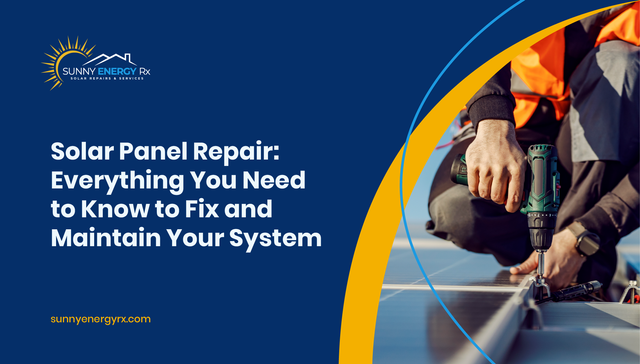Arizona Solar Panel Repair Playbook: Spot Issues Early, Fix Them Right, Protect Your Savings
Arizona Solar Panel Repair: From First Signs to the Right Fix
This blog was originally published on Sunny Energy RX.
Arizona’s sunshine powers your home and your ROI, but the same heat, dust, and monsoon grit can quietly knock a healthy solar system off its stride. A sudden dip in production on a clear week, a restless inverter light, or a battery that never quite charges are your early check-engine signals. Acting on them quickly keeps energy flowing, safeguards your roof and warranties, and prevents small problems from becoming big bills.
How to Tell It’s Repair Time
Most issues start subtly. Watch your monitoring trends across several sunny days, not just a single afternoon. If output falls without a weather explanation or your inverter shows new warnings, it’s time to look closer. From the ground (binoculars help), scan for anything off: a panel that sits slightly askew, bird nesting material, or grime that rain never removes.
Common signs include:
- Unexplained production drops
- Red or amber inverter indicators or error codes
- Frequent shut-offs or restarts during hot afternoons
- Rising utility charges despite similar usage
- Batteries that won’t top up
- Visible trouble such as cracked glass, brown hot-spot marks, loose conduit, or chewed wiring
Safe Checks You Can Do Today (No Tools, No Ladders)
Start with a manufacturer-approved reboot sequence, usually AC off, then DC, reversing to power back up. Confirm breakers and exterior disconnects haven’t tripped. Make sure your monitoring device is online; a Wi-Fi hiccup can masquerade as no production. Give the inverter breathing room by clearing stored items from around its vents (but never open the casing). Finally, document what you see: photos of error lights or codes, dates, temperatures, and any recent storms. That context helps a technician diagnose in minutes instead of hours.
If you smell burning plastic, hear arcing or aggressive buzzing, notice scorch marks, or experience repeatedly tripping breakers, stop there and call a professional immediately.
What a Professional Repair Visit Should Include
Good repair work is methodical, not guess-and-check. Expect a focused diagnostic on the inverter (reviewing logs, codes, communications), followed by electrical health checks on visible wiring, racking, grounding, and roof penetrations. A technician should compare expected vs. actual output to pinpoint underperforming strings or shaded modules, then explain root cause in plain language.
You’ll get a written plan with repair-vs-replace options, parts details, timelines, and an itemized quote before work begins. After the fix, a post-repair verification should confirm production is back where it belongs. Keep the photos and report they’re useful for warranties and future trend tracking.
Repair vs. Replace: Make the Smart Call
Electronics age faster in desert heat. If an older inverter or repeatedly failing component costs nearly as much to repair as to replace, a new unit may be the better long-term play. A service-first provider will put both choices side-by-side, showing cost, warranty coverage, and projected reliability, so you can decide with confidence. For module-level issues (microinverters, optimizers, or a single panel), targeted swaps can restore performance without touching the rest of the array.
Prevent Repeat Breakdowns in the Desert
Prevention is the cheapest repair you’ll ever buy. Keep airflow clear around your inverter and avoid heat-trap locations. Use your monitoring app monthly (and after dust storms) to look for trends, not single-day blips. Schedule periodic inspections and safe cleanings to remove baked-on dust and catch loose hardware early. If birds love your roofline, install guards to keep them from nesting under the array.
A simple rhythm works: monitor monthly, scan from the ground after storms, and keep a regular service cadence. These small habits keep production steady through Arizona’s longest sunny seasons.
Your Next Step
If you’re seeing warning lights, persistent production dips, or anything that feels off, don’t wait for the next utility bill to confirm it. Book a professional diagnosis with a repair-focused team that explains clearly, quotes transparently, and documents everything. You’ll restore performance faster and protect your system for the long haul.
Ready to Get Your Solar Back to Peak?
Schedule a professional solar panel repair with Sunny Energy RX for targeted diagnostics, expert fixes and a prevention plan built for Arizona.
Don’t let desert heat dim your savings. Bring your system back to full shine with Sunny Energy RX.
